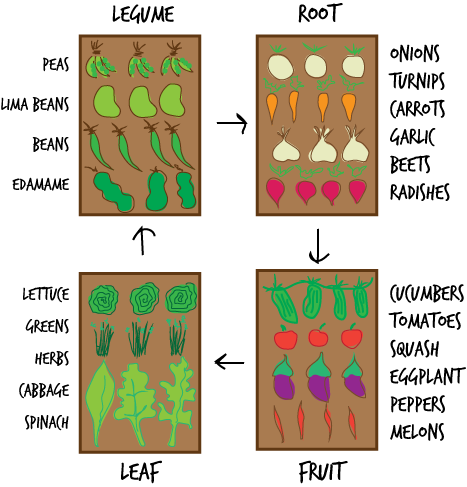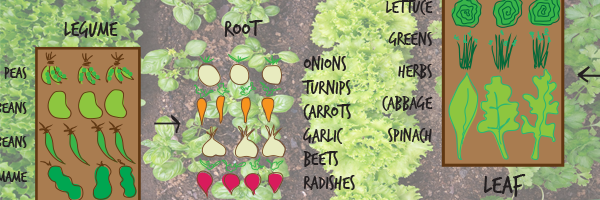Last week we talked about preparing the vegetable garden by pulling the leftover plants and weeds and turning in plenty of new compost. Next we need to think about what we are going to plant this fall and where in the garden we are going to plant it. Each season is a challenge to grow everything you want to with limited space. And then there’s that term crop rotation. Do I really have to? I like my tomatoes at that end of the garden.
 Simply put, crop rotation is a systematic method of deciding what to plant where in your garden from one season to the next, based on plant groups. Moving plants to a new location each season improves your garden in two ways. First, it helps keep your soil healthy and fertile. Planting the same thing in the same place season after season drains the nutrients from the soil that the plant needs in order to thrive and produce big harvests. Second, rotating plant families helps manage soil-borne diseases like verticillium wilt, and soil-dwelling insects like corn rootworms or root knot nematodes. These types of diseases and pests prefer certain kinds of plants, and the longer the plants stay in the same soil, the better the chance that these enemies will show up and cause trouble.
Simply put, crop rotation is a systematic method of deciding what to plant where in your garden from one season to the next, based on plant groups. Moving plants to a new location each season improves your garden in two ways. First, it helps keep your soil healthy and fertile. Planting the same thing in the same place season after season drains the nutrients from the soil that the plant needs in order to thrive and produce big harvests. Second, rotating plant families helps manage soil-borne diseases like verticillium wilt, and soil-dwelling insects like corn rootworms or root knot nematodes. These types of diseases and pests prefer certain kinds of plants, and the longer the plants stay in the same soil, the better the chance that these enemies will show up and cause trouble.
Here are four simple families of plants to group and rotate each season:
The Tomato Family
The tomato family includes tomatoes, eggplant, peppers, and potatoes. These are heavy feeders and are best planted in enriched soil. Tomato family members often are also affected by the same diseases. Never follow tomatoes after potatoes because deadly late blight can overwinter in potatoes that might have been missed and remain in the soil.
The Bean Family
These crops enrich the soil by adding a little nitrogen. This group includes green beans, green peas, and southern peas. A good gardening practice is to follow beans or peas with leafy greens such as cabbage or kale which love the nitrogen left behind by their predecessors.
The Squash Family
Squash family members are heavy feeders that grow best in rich soil also. They include summer and winter squash, pumpkins, gourds, cucumbers, and melons (including cantaloupe and watermelon).
The Cabbage Family
These leafy greens thrive on nitrogen-rich soil. Plant them where a member of the bean family has grown before. Members include cabbage, broccoli, cauliflower, kale, collards, and turnip greens.
 Crop rotation is not as complicated as it sounds, especially if you take the time to sketch a garden plan and refer to the list of families. The benefits are definitely worth the effort.
Crop rotation is not as complicated as it sounds, especially if you take the time to sketch a garden plan and refer to the list of families. The benefits are definitely worth the effort.
-DeAnna



Christine says
Hi!
I’m confused about rotation. The diagrams I’ve seen are yearly but we work on seasons. I live in Central Queensland so can grow most veg all year. Say I plant carrots in bed 1 in spring can I continuously grow carrots for the entirety of year 1 then m9ve carrots to another bed for year 2?
Jesse Jenkins says
Hi Christine – if you continue to plant the same crop in the same area long term, you run the risk of developing soil-born diseases and insects. You should be fine planting carrots in the same location for a couple of seasons, then rotating. But always check with your local garden center or gardening resource for specific information for your area.
Dee says
Hello,
Concerning tomatoes grown in pots, should rotation be a concern? If so, what do you do to solve the problem? Thanks, Dee
james says
Yes its a concern, but not a major one. Potting soil degrades over time so you should not be using the same potting soil after 2 or 3 years, so not as much chance of disease or nematode buildup. Also, it is easier to “solarize” potting soil in the summer sun. Once your crop is done late spring, make sure the pot is in full hot sun, water the potting soil, then wrap in clear plastic to bake for a couple of weeks, high temperatures will kill most organisms. I copied this from a vegetable grower site, they recommend new potting soil every season, which eliminates any need to rotate.
” Clean Up at Season’s End. Remove spent tomato plants from the pots at the end of the growing season. If you plan to use the same pots to grow anything in the tomato family (think tomatoes peppers, eggplants, potatoes) during the following season, you’ll want to start with fresh soil. Discard any remaining soil, wash and scrub soil from pots, then sterilize them by wiping or spraying with a solution of one part bleach to 10 parts water.”